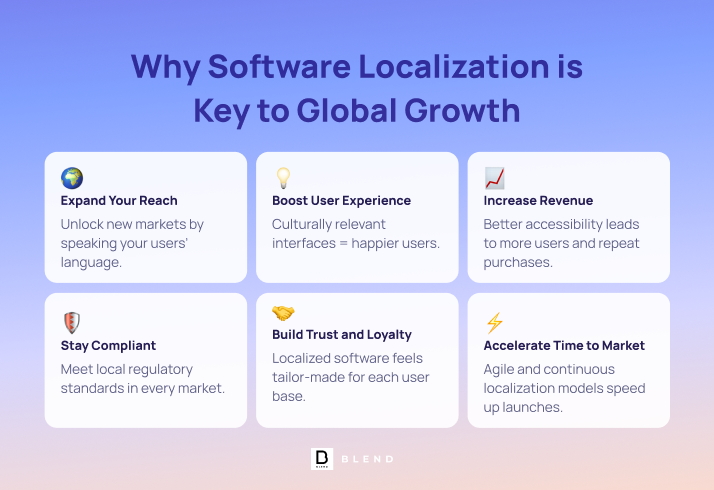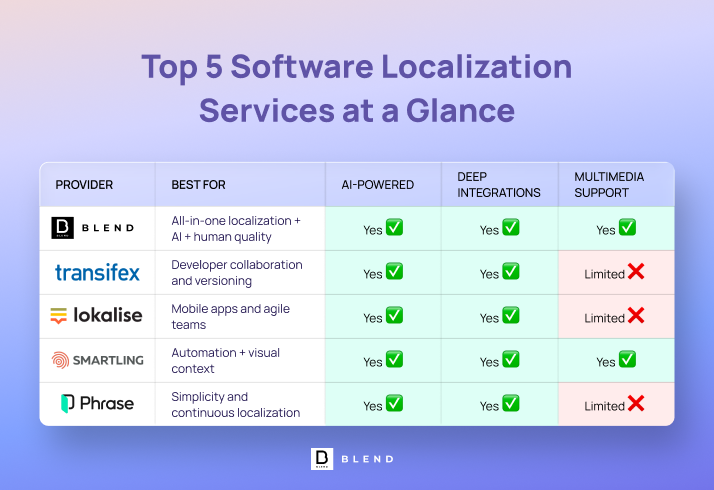
10 Best Software Localization Services: What to Look for in 2025
Simply put, software localization involves adapting software from one language to another to meet the distinct language and cultural needs of a target market. It also involves adapting software to fall in line with new regulatory requirements. The localization process is an involved one, including the translation of everything from user interfaces to documentation.
What’s more, the software design and functionality may also need to be heavily adapted to accommodate changes. This generally involves adapting things like time and date formats, measurement units, currencies, and more. All of this results in software products that are more user-friendly for native users and relevant to the individual needs of new markets.
Interested in localizing your software products? Undertaking the process alone can be daunting, with most companies falling short when it comes to in-house talent and resources. Fortunately, the best localization services can help plug the shortfall, bringing those vital elements to help you succeed in new markets.
Software Localization Explained
Localizing software yields more benefits than standard translation. It dramatically improves user experience, thereby improving customer satisfaction, adoption, and retention rates. By making software products more accessible to wider audiences, companies can significantly expand their global reach, helping them succeed when it comes to expansion efforts.
Localized software also gives companies a competitive edge, allowing them to compete in saturated international markets, boost sales, secure a strong brand identity, and boost loyalty. Equally as important, software localization ensures companies adhere to local regulations while reducing the risk of miscommunications and embarrassing faux pas, which can both cause irreparable damage to a brand’s reputation. If you’re serious about succeeding in a global context, software localization is a must.
Why You Should Be Thinking About Software Localization
If you want to expand into international markets and achieve sustainable growth, software localization is essential. Without it, you can’t ready your digital products for new markets and succeed in the competitive software market. Admittedly, localization can seem daunting, while the process can carry a high price tag. However, when executed successfully, the return on investment is high, with localization yielding many benefits.

Boost Your Customer Base
Many companies make the mistake of only offering their software in English. While a significant proportion of the global population speaks English, the majority of software and app users speak non-English languages. If you’re eyeing up a target market where English is a non-native language, it makes sense to localize if you want to ensure an enhanced user experience and convert users. The more you cater to the specific linguistic and cultural needs of users, the more likely they are to become loyal users.
Build Brand Visibility
If you want to secure new customers in untapped territories, you need to build brand awareness. This is nigh on impossible without localization, with the process the only real way of making the right first impression with international audiences. By investing in brand awareness, you can reduce marketing and advertising costs, while boosting brand value.
The result is a more identifiable product that better appeals to potential customers. Strong brand awareness is particularly important if you’re operating in a saturated market or your competitor software products currently exist within said market.
Expedited Time to Market
When you invest time and resources into software localization, you can enjoy a faster time to market. You can speed up the process of launching into new markets considerably if you’ve invested in continuous workflows, with localization being part of the development process since the beginning.
The agile localization model involves developers and localization professionals collaborating from the very beginning of a product lifecycle. Continuous localization is similar, but here, localized content is consistently ready for release. The more your developer and translation teams collaborate, the shorter product lifecycles become. Both models are useful if you plan on launching in multiple markets at once or want to localize at scale.
Foster Trust and Loyalty with Customers
Customers prefer products that feel as though they’ve been created with them in mind. At a minimum, this calls for software that’s been developed in their native language. When you offer software in the native tongue of new users, you’re demonstrating that you care about them as a customer base. High-quality localization results are particularly welcome and are useful if you’re looking to boost loyalty and turn one-time customers into brand advocates.
Enjoy Increased Revenues
All of the above benefits ultimately combine to deliver increased revenues. The bigger your customer base becomes, the healthier your revenues. Localization also allows you to enjoy significant cost savings. By investing early on in creating a native user experience, you can dramatically reduce churn rate, secure repeat orders, and achieve invaluable word-of-mouth marketing.
How Does the Localization of Software Work
The software localization process is somewhat similar to general translation; however, workflows are more involved with more complex steps. Interdisciplinary teams are at the heart of any software localization project, with project managers, developers, linguists, and quality assurance professionals all working closely alongside each other.
The software localization process typically starts by identifying target markets. Once you’ve determined which languages and regions you plan on targeting, you’re ready to internationalize your software. This step involves separating translatable text from code and ensures software elements are readily adaptable to different languages. During this step, you’ll want to identify all resources that will be translated, including text, images, videos, and more.
Once you’ve done all this, you can start selecting localization tools and service providers. You can opt to bring together many individual tools like translation management systems and machine translation tools, or opt for an all-in-one platform that combines all of them.
Now you’re ready to move onto the translation stage itself. First, translatable strings need tio be extracted from source code and stored in separate resource files. With this done, you’re ready to translate the text itself. Alongside text, additional content and visuals will need to be culturally adapted for new audiences. Terminology management tools can prove useful in maintaining consistency during this stage, reducing the burden on translation reviewers and editors.
Technical aspects of a software product now also need to be adapted. Elements like data and time formats, as well as currency and numbers, are covered here. Keyboard layout may need also need to be adjusted, while the overall layout of pages may need to be altered to accommodate differences in language direction.
At this point, testing and quality assurance can begin. After first proofing translated text itself, the software can undergo functional testing to ensure it performs as it should. It then needs to undergo usability testing to evaluate user experience, as well as performance testing. The software is then ready for release to market.
The 10 Best Software Localization Services in 2025
Planning a localization project and keen to lighten the load? Make sure you’re choosing a localization project that brings together the best talent with industry-leading tools and AI features. To help you make your decision, we’ve singled out 10 of the best software localization services for you to consider in 2025.

1. BLEND
BLEND is an all-in-one localization service that enables global reach, bringing together a diverse talent pool with deep tech integrations. This AI-powered platform makes full use of AI and machine learning, helping streamline the translation process considerably. Perfect if you’re looking to reduce turnaround times and slash costs. You also benefit from access to a huge linguist network, with thousands of translators working in more than 120 languages. Whether you’re looking to target saturated markets or are interested in less likely language pairs, you’re well served by BLEND.
Interested in multimedia localization to supplement your software project? As well as extensive experience with software localization projects, BLEND can help you handle the localization of multiple file formats and media types, including images, audio, and video. This cutting-edge platform also supports integration with various systems, allowing you to connect your content management systems, translation management systems, and other tools of your choice. Ideal if you’re looking to create a tailored workflow.
Despite being one of the more exchausive localization platforms out there, BLEND is surprisingly user-friendly, with an intuitive dashboard that simplifies project management and remains accessible to every team member.
Best for all-in-one localization with global reach and deep tech integrations.
2. Transifex
If you’re looking for a localization service that will enable your developer teams with real-time updates and Git integrations, Transifex is a good choice. This localization platform is surprisingly comprehensive, featuring everything from translation management to version control. You’ll also find a suite of collaboration tools to support interdisciplinary workflows. A huge variety of file formats is supported here, while APIs allow for hassle-free integration with a range of different development systems and tools.
3. Lokalise
Searching for something to design mobile apps or facilitate agile workflows? Lokalise is a good option. This user-friendly platform is a good fit for beginners with minimal platform experience, while a customizable interface allows you to adapt it to meet the specific needs of your projects. Automation translation suggestions make quick work of adapting content, while automated QA checks can also help speed up everyday processes. Lokalise also integrates with a wide variety of tools and services, allowing you to make use of a wide variety of useful tools and systems.
4. Smartling
Those looking for AI-powered translation and automation will be well served by Smartling. A user-friendly interface makes this an intuitive platform for the uninitiated, with first-time users able to get used to most features. It also supports wide integration with a variety of tools and platforms, making it a particularly customizable option. Those searching for an end-to-end solution are also well provided for, with Smartling making quick work of the entire software localization process. Visual context features make this particularly appealing for those looking to lighten the load for translators, with added context making difficult translations a breeze.
5. Phrase
With a user-friendly interface and broad raft of features, Phrase is a sound bet for any software localization project. This cloud-based localization platform prioritizes simplicity, which will benefit those new to localization but may alienate more experienced users. All the usual features you’d expect are present and correct here, including translation management tools, team collaboration features, and more. Continuous localization is supported, with API integrations allowing you to create a highly customized localization platform.
6. Memsource
In the market for an enterprise-level localization service? It’s worth giving Memsource a second look. This cloud-based localization platform is surprisingly user-friendly, with a simple interface that makes it an accessible choice. Its cloud-based nature also makes it ideal for collaboration, enabling scattered teams to work from anywhere. Robust translation memory and terminology management also come as standard, ensuring consistency and efficient workflows. Meanwhile, AI features and automation make it a scalable solution and ideal for those looking to raise their game.
7. POEditor
Looking for a lightweight alternative to the more complicated localization platforms out there? If you’re after something more streamlined, POEditor is certainly worth investigating. This platform is geared more toward the developer, but that’s not to say that linguists and other localization team members will feel alienated. All the standard features you’d expect can be found here, including project tracking tools, glossary management, and translation memory. POEditor also supports API integrations, enabling you to connect with the tools and systems of your choice.
8. Crowdin
If you’re working with open-source teams and want a solution that supports collaboration, Crowdin is something to think about. This localization platform can be used by small companies and enterprise-level clients alike, with a host of useful features including glossary management and translation memory. You’ll also benefit from real-time collaboration features, making it an ideal choice if you’re looking to deploy agile workflows. Integration with popular tools and systems allows you to create a truly tailored localization solution.
9. Localize
For those that prefer simplicity, a platform like Localize is a good shout. This user-friendly platform is designed for clients of all sizes, with a quick setup and easy integration with most web platforms, allowing you to create a customizable solution that works for you. Translation management tools and effective version control features support collaborative workflows and interdisciplinary teams, while support for a wide variety of formats and integrations lets you connect with most platforms and systems.
10. Smartcat
Need some help finding linguists to helo complete your localization project? With its built-in linguist marketplace, Smartcat is an obvious choice. AI technology pairs you with the best editors and translators for the job, while this cloud-based system helps streamline the development process considerably with automated workflows. Smartcat AI automatically translates text and reviews output, while a collaborative TMS ensures every team member is on the same page and can view project progress.
How to Choose the Best Localization Service for Your Needs
To ensure you’re selecting the right localization partner for your needs, first as yourself a few key questions before making your choice. Firstly, determine which markets you’re planning on targeting. Once you’ve hammered out which languages you’ll be targeting, you can be confident that you’re choosing a provider with sufficient experience. Next, decide on the scope of your project. Some service providers may be comfortable enough with small software localization projects, while others will have the expertise and resources to support enterprise-level project workflows.
Looking to automate workflows and tap into the power of artificial intelligence? You’ll need a localization service provider that offers AI-enabled solutions as standard. Generally speaking, you’ll want a clear idea of the tools and technology they’re using. Make sure you’re fully versed on any translation tools they’re using, alongaaside any project management systems they have in place. If you plan on using your own tools and platforms, make sure you’re choosing a localization service with integration capabilities so you can create a customized localization solution.
Ready to get your software localization off the ground? If you’re after a localization service provider with tired and tested experience, not to mention to the right tools to help you make a name for yourself on the world stage, choose BLEND. Our industry-leading solutions bring together powerful AI tools and automation technology with the best human talent in the industry. Combine time-saving machine translations with the constant oversight of experienced human linguists, and enjoy seamless integrations with a host of tools and platforms for a customized localization suite that works for you.
Interested in learning more about how we can help you with your software localization project? Get in touch with the team today.
Need fast, high-quality translation?
Translate nowWhat our customers are saying






